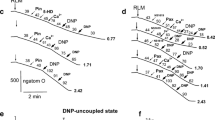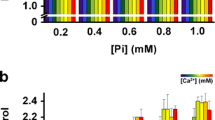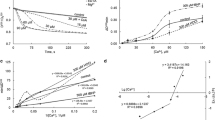Abstract
A rapid loss of accumulated Ca2+ is produced by addition of H+ to isolated heart mitochondria. The H+-dependent Ca+ efflux requires that either (a) the NAD(P)H pool of the mitochondrion be oxidized, or (b) the endogenous adenine nucleotides be depleted. The loss of Ca2+ is accompanied by swelling and loss of endogenous Mg2−. The rate of H+-dependent Ca2+ efflux depends on the amount of Ca2+ and Pi taken up and the extent of the pH drop imposed. In the absence of ruthenium red the H+-induced Ca2+-efflux is partially offset by a spontaneous re-accumulation of released Ca2+. The H+-induced Ca2+ efflux is inhibited when the Pi transporter is blocked withN-ethylmaleimide, is strongly opposed by oligomycin and exogenous adenine nucleotides (particularly ADP), and inhibited by nupercaine. The H+-dependent Ca2+ efflux is decreased markedly when Na+ replaces the K+ of the suspending medium or when the exogenous K+/H+ exchanger nigericin is present. These results suggest that the H+-dependent loss of accumulated Ca2+ results from relatively nonspecific changes in membrane permeability and is not a reflection of a Ca2+/H+ exchange reaction.
Similar content being viewed by others
References
Adam, H. (1965). InMethods of Enzymatic Analysis (Bergmeryer, H. U., ed.), Academic Press, New York, pp. 539–543; 573–577.
Akerman K. E. O. (1978).Arch. Biochem. Biophys. 189 256–262.
Altschuld, R. A., Hostetler, J. R., and Brierley, G. P. (1981).Circ. Res. 49 307–316.
Asimakis, G. K., and Sordahl, L. A. (1981).Am. J. Physiol. 241 H672-H678.
Brierley, G. P., Jurkowitz, M., Chavez, E., and Jung, D. W. (1977).J. Biol. Chem. 252 7932–7939.
Carafoli, E. (1981). InMitochondria andMicrosomes (Lee, C. P., Schatz, G., and Dallner, G., eds), Addison-Wesley, Reading, Massachusetts, pp. 357–374.
Coelho, J. L., and Vercesi, A. E. (1980).Arch. Biochem. Biophys. 204 141–147.
Cromptom, M., and Heid, I. (1978).Eur. J. Biochem. 91 599–608.
Dawson, A. P., and Fulton, D. W. (1980).Biochem. J. 188 749–755.
Fiskum, G., and Lehninger, A. L. (1979).J. Biol. Chem. 254 6236–6239.
Harris, E. J., and Cooper, M. B. (1981).Biochem. Biophys. Res. Commun. 103 788–796.
Haworth, R. A., and Hunter, D. R. (1980).J. Membr. Biol. 54 231–236.
Hohl, C., Ansel, A., Altschuld, R., and Brierley, G. P. (1982).Am. J. Physiol. 242 1022–1030.
Jung, D. W., and Brierley, G. P. (1981).J. Biol. Chem. 256 10490–10496.
Jung, D. W., Chavez, E., and Brierley, G. P. (1977).Arch. Biochem. Biophys. 183 452–459.
Lehninger, A. L., Vercesi, A., and Bababuni, E. A. (1978).Proc. Natl. Acad. Sci. U.S. 75 1690–1694.
Lowenstein, J. M., and Chance, B. (1968).J. Biol. Chem. 243 3940–3946.
Nicholls, D. G. (1978).Biochem. J. 176 463–474.
Nicholls, D. G., and Brand, M. D. (1980).Biochem. J. 188 113–118.
Nicholls, D. G., and Crompton, M. (1980).FEBS Lett. 111 261–268.
Nicholls, D. G., and Scott, I. D. (1980).Biochem. J. 186 833–839.
Palmer, J. W., and Pfeiffer, D. R. (1981).J. Biol. Chem. 256 6742–6750.
Panov, A., Filippova, S., and Lyaknovich, V. (1980).Arch. Biochem. Biophys. 199 420–426.
Pfeiffer, D. R., Schmid, P. C., Beatrice, M. C., and Schmid, H. H. O. (1979).J. Biol. Chem. 254 11485–11494.
Prpic, V., and Bygrave, F. L. (1980).J. Biol. Chem. 255 6193–6199.
Roman, I., Gmaj, P., Nowicka, C., and Angielski, S. (1979).Eur. J. Biochem. 102 615–623.
Saris, N. E. L., and Akerman, K. E. O. (1980).Curr. Top. Bioenerg. 10 103–179.
Scarpa, A., Brinley, F. J., Jr., and Dubyak, G. (1978).Biochemistry 17 1378–1386.
Shi, G-Y, Jung, D. W., Garlid, K. D., and Brierley (1980).J. Biol. Chem. 255 10306–10311.
Struder, R. K., and Borle, A. B. (1980).Arch. Biochem. Biophys. 203 707–718.
Tsokos, J., Cornwell, T. F., and Vlasuk, G. (1980).FEBS Lett. 119 297–300.
Vercesi, A., Reynefarje, B., and Lehninger, A. L. (1978).J. Biol. Chem. 253 6379–6385.
Waite, M., Scherphof, G. L., Boshouwers, F. M. G., and Van Deenen, L. L. M. (1969).J. Lipid Res. 10 411–420.
Wolkowitz, P. E., and McMillan-Wood, J. (1981).Arch. Biochem. Biophys. 209 408–422.
Zoccarato, F., Rugolo, M., Siliprandi, D., and Siliprandi, N. (1981).Eur. J. Biochem. 114 195–199.
Author information
Authors and Affiliations
Rights and permissions
About this article
Cite this article
Jurkowitz, M.S., Brierley, G.P. H+-dependent efflux of Ca2+ from heart mitochondria. J Bioenerg Biomembr 14, 435–449 (1982). https://doi.org/10.1007/BF00743069
Received:
Revised:
Issue Date:
DOI: https://doi.org/10.1007/BF00743069




